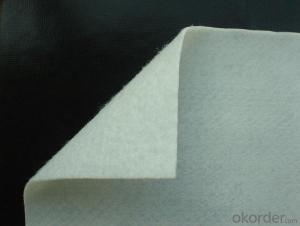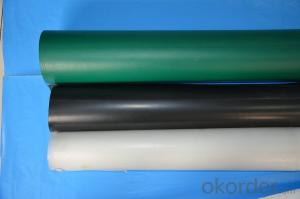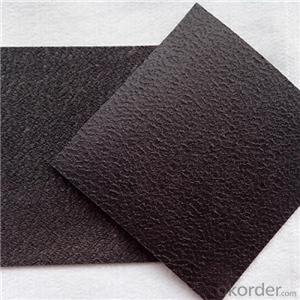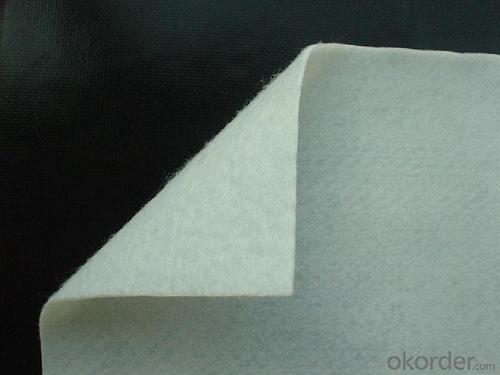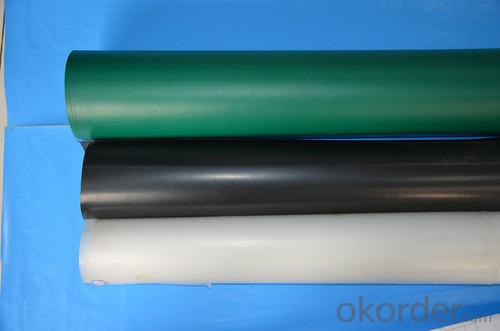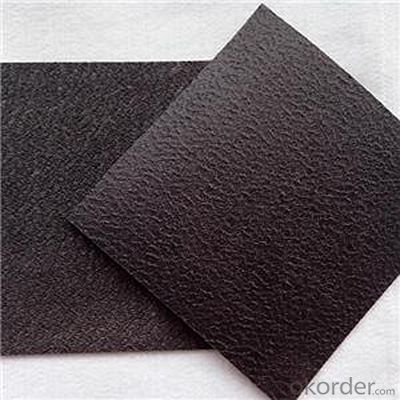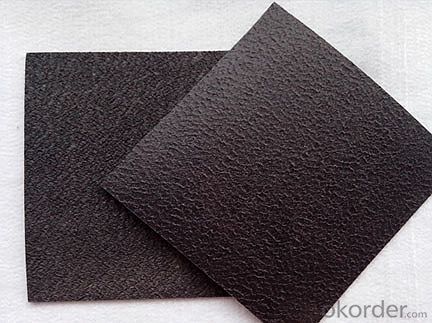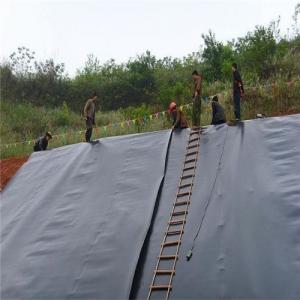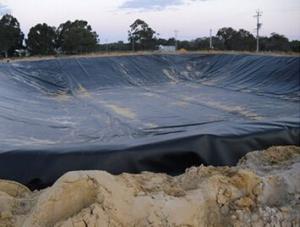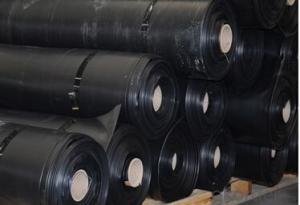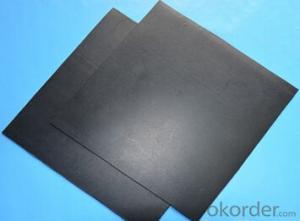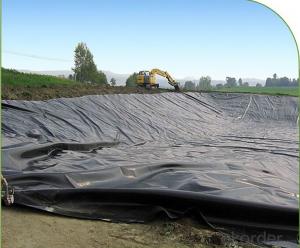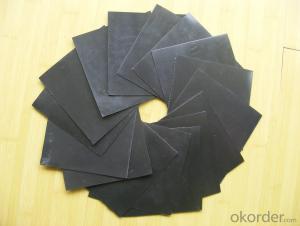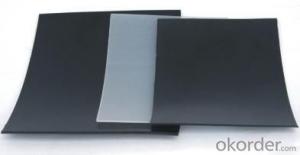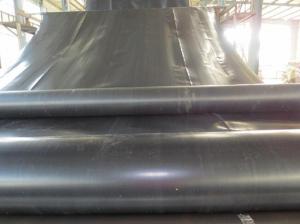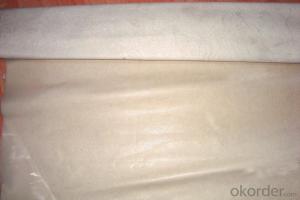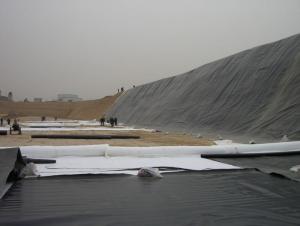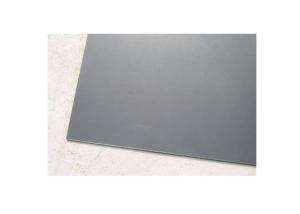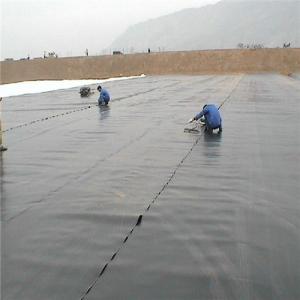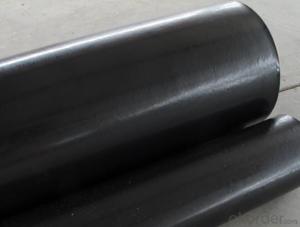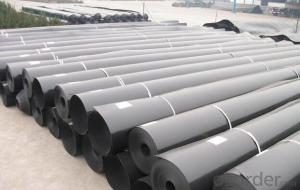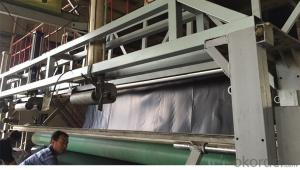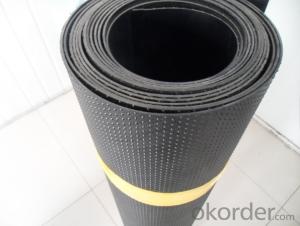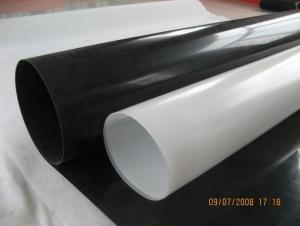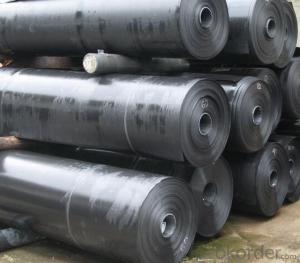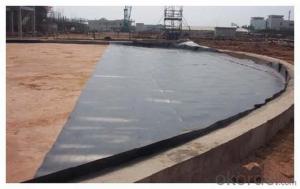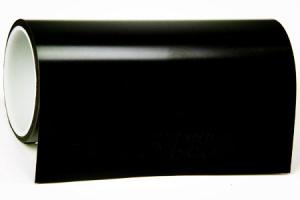HDPE Geomembrane Specifications - Waterproofing Geomembrane Manufacturer from China
- Loading Port:
- China main port
- Payment Terms:
- TT OR LC
- Min Order Qty:
- 1000 m²
- Supply Capability:
- 1000000 m²/month
OKorder Service Pledge
OKorder Financial Service
You Might Also Like
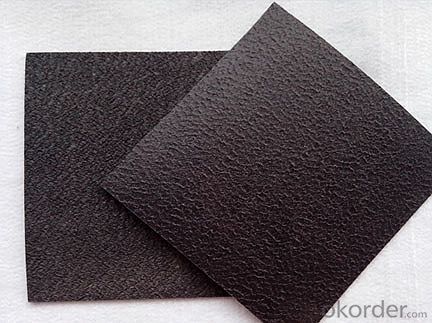
Application
1. Environmental protection, sanitation (such as solid waste landfills, sewage treatment plants, power plants Chi-conditioning, industrial, hospital solid waste, etc.) .
2. Water (such as rivers, lakes and reservoirs of the anti-dam, plugging, reinforcement of the canal seepage, the vertical wall of the heart, slope protection, etc.).
Properties :
It is of excellent physical and hydraulic properties, and especially its advantanges in the tensile strength,longitudinal and lateral strength ratio,uniformity and so on.
Supply a wide range of color,such as white,green and grey.Independent developed soft green fiber can protect installer's eyes at the onsite during work under the strong light,and it is eco-friendly productions.
Applicable to river dams, tunnels, drainage bank seepage, metallurgy and chemical industry pollution prevention, construction, transportation, environmental protection works.
Our Service
Quality assurance
1.On a regular basis or as per your request,we entrust national testing agencies to conduct quality inspections
2. Strictly in accordance with the ISO9001-2008 international quality system standard,we monitor and manage the whole process throughout production,quality testing,and measurement to ensure product quality
3. For quality-related construction delay or substandard construction(except for damage or losses due to customer’s responsibility or irresistible natural disasters),we have refunding,replacement,and repair services.We will respond to customers’ feedbacks on quality issues within 24 hours.
FAQ:
Q: What kind of payments does jenor support?
A: T/T, L/C, Cash are accepted.
Q: Do you charge for the samples?
A: Accordeing to our company policy, the samples are free, we only charge the freight fee. And we will return the freight fee during the next order.
Q: Can you produce according to customers' design?
A: Sure, we are professional manufacturer, OEM and ODM are both welcome.
Q: Do you have other products?
A: Yes, please check the pictures:
- Q: What are the requirements for geomembranes used in biogas plants?
- The requirements for geomembranes used in biogas plants include high chemical resistance to withstand the corrosive nature of biogas components, excellent impermeability to prevent gas leakage, durability to withstand long-term exposure to UV radiation and varying weather conditions, and flexibility to accommodate the shape and contours of the biogas plant structures. Additionally, they should meet specific industry standards and regulations to ensure their suitability for biogas applications.
- Q: Electrothermal?film and electric?hot?plate, which one is better?
- Electrothermal?film is recommended, the external transfer form of heat energy produced by it is thermal infrared radiation and convection, the conversion rate between electric energy and heat energy is more than 98%, which can immediately rise the temperature and ensure the stability of the indoor temperature, play the role of comfort, energy-saving and durability, safety. It is a worthy option.
- Q: How good of the quality of waterproof electrothermal?film?
- Waterproof electrothermal?film is the only surface heating product that can be implanted in the concrete.
- Q: Is far infrared ray electrothermal film good?
- Far infrared electric heating film is very good. You can try it.
- Q: In which areas can electronic Whiteboard film be used?
- Electronic whiteboard can be regarded as a projective plane of the desktop computer, computer can be directly controlled on the electronic whiteboard, electromagnetic induction uses electromagnetic pen to touch, so that computer can be directly controlled on the electronic whiteboard. There is no need of mouse control back to the computer. In addition, the electronic whiteboard has supporting softwares which can annotate during teaching. This function is good, it is an alternative to ordinary whiteboard to make dust free teaching come ture.
- Q: What is the working principle of the electric heating film
- It uses full transparent high temperature electric heating film as the heating material, which is processed by world leading technology. The hot air passage structure is adopted to enhance the heat transfer mode, and the heat starting will be faster, and the temperature of the air outlet is more than 100 in 3 minutes, but it will imeediately cool off. Because the electric heating film itself is oxidation free, and its service life can be in 100 thousand hours, and at the same time it has the characteristics of small size, beautiful appearance, etc., belonging to the generation of the electric heating device. Thermosyphon tube heater is a new electric?heater sold this year, it uses the two-phase closed thermosyphon "as the heat source, which heats fastly with high thermal efficiency. It does not give out light, produce no flame, not afraid of water and water vapor corrosion. It is suitable for ordinary room and bathroom
- Q: Can geomembranes be used for floating covers?
- Yes, geomembranes can be used for floating covers.
- Q: What are the limitations of geomembranes in high-chemical concentration environments?
- Geomembranes are typically used as barriers to prevent the migration of chemicals in various environments. However, in high-chemical concentration environments, there are several limitations to their effectiveness. Firstly, some chemicals may be highly reactive and can degrade the geomembrane material, leading to reduced performance and integrity over time. Additionally, certain chemicals may have a high diffusion rate, making it challenging for the geomembrane to effectively contain and resist their migration. Moreover, the presence of high chemical concentrations can increase the likelihood of punctures or tears in the geomembrane, compromising its ability to act as a barrier. Therefore, it is crucial to carefully consider the specific chemical properties and concentrations when selecting and designing geomembranes for high-chemical concentration environments.
- Q: What are the advantages of using geomembranes in coastal protection projects?
- Geomembranes offer several advantages in coastal protection projects. Firstly, they act as a barrier to prevent erosion and soil loss, effectively protecting the coastline from the damaging effects of waves and currents. This helps maintain the integrity of the beach or shoreline and minimize the need for costly and time-consuming maintenance. Secondly, geomembranes can be easily installed and customized to fit specific project requirements. They are flexible and can be shaped to match the contours of the coastline, ensuring a seamless and tight seal. This adaptability allows for efficient and effective protection of vulnerable areas. Furthermore, geomembranes are durable and resistant to UV radiation, chemicals, and other environmental factors. This longevity ensures that coastal protection projects can withstand the test of time and continue to provide effective protection for extended periods. Additionally, these membranes are impermeable, preventing water infiltration and reducing the risk of seepage or flooding in coastal areas. This is particularly crucial in areas prone to storms or rising sea levels, as it helps safeguard infrastructure, ecosystems, and communities. Overall, the use of geomembranes in coastal protection projects offers cost-effective, efficient, and durable solutions to combat erosion and protect vulnerable coastlines.
- Q: Generally, how many welding rods are needed when welding the impoted geomembrane of ten thousand square meters?
- I can not tell you precisely how many welding rods are needed as it is related to the terrain of your project, soil environment, and design. Based on simple estimation, it seems that 35 or 36 kilograms of rods are needed.
Send your message to us
HDPE Geomembrane Specifications - Waterproofing Geomembrane Manufacturer from China
- Loading Port:
- China main port
- Payment Terms:
- TT OR LC
- Min Order Qty:
- 1000 m²
- Supply Capability:
- 1000000 m²/month
OKorder Service Pledge
OKorder Financial Service
Similar products
Hot products
Hot Searches
Related keywords
